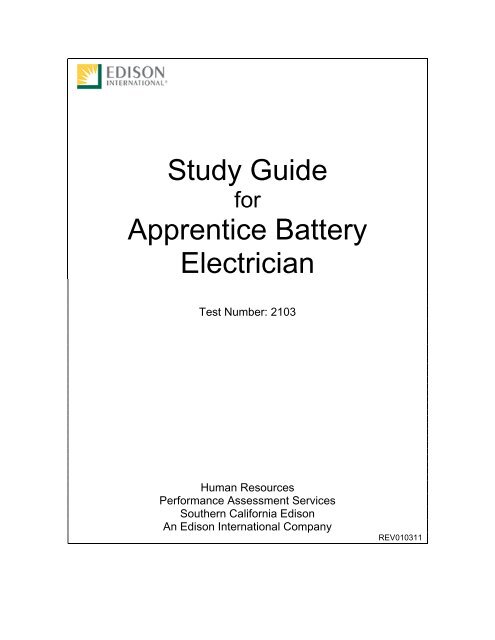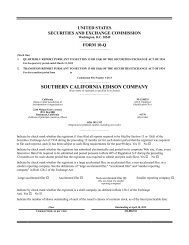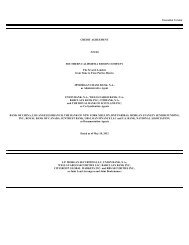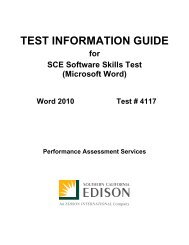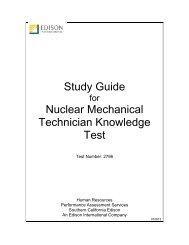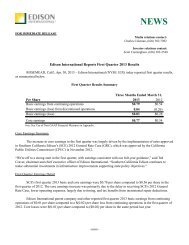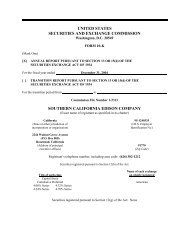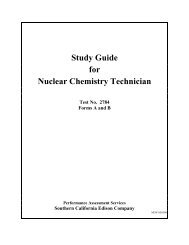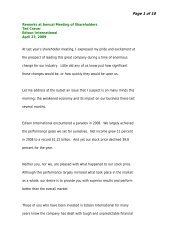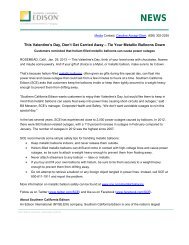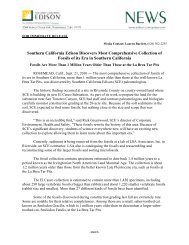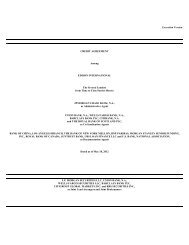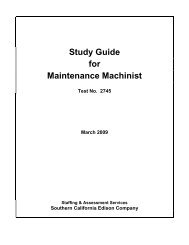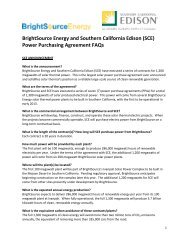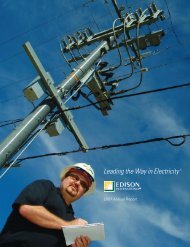Study Guide Apprentice Battery Electrician - Edison International
Study Guide Apprentice Battery Electrician - Edison International
Study Guide Apprentice Battery Electrician - Edison International
You also want an ePaper? Increase the reach of your titles
YUMPU automatically turns print PDFs into web optimized ePapers that Google loves.
<strong>Study</strong> <strong>Guide</strong><br />
for<br />
<strong>Apprentice</strong> <strong>Battery</strong><br />
<strong>Electrician</strong><br />
Test Number: 2103<br />
Human Resources<br />
Performance Assessment Services<br />
Southern California <strong>Edison</strong><br />
An <strong>Edison</strong> <strong>International</strong> Company<br />
REV010311
Introduction<br />
The 2103 <strong>Apprentice</strong> <strong>Battery</strong> <strong>Electrician</strong> Test is a job knowledge tests designed to<br />
cover the major knowledge areas necessary to perform these jobs. This <strong>Guide</strong> contains<br />
strategies to use for taking tests and a study outline, which includes knowledge<br />
categories, major job activities, and study references.<br />
Test Session<br />
It is important that you follow the directions of the Test Administrator exactly. If you have<br />
any questions about the testing session, be sure to ask the Test Administrator before the<br />
testing begins. During testing, you may NOT leave the room, talk, smoke, eat, or drink.<br />
Since some tests take several hours, you should consider these factors before the test<br />
begins.<br />
All cellular/mobile phones, pagers or other electronic equipment will NOT be<br />
allowed in the testing area.<br />
All questions on this test are multiple-choice or hot spot questions. Multiple choice<br />
questions have four possible answers. Hot spot questions have a picture, and you must<br />
click the correct spot on the picture to answer the question. All knowledge tests will be<br />
taken on the computer. For more information on this, please see the next section of this<br />
study guide on Computer Based Testing.<br />
The test has a three hour time limit. A non-programmable scientific calculator will<br />
be provided for you to use during the test. The calculator provided during the test<br />
session will be one of these models:<br />
Casio fx-250HC,<br />
Texas Instruments TI-30XA,<br />
Texas Instruments TI-36X<br />
You will NOT be able to bring or use your own calculator during testing.<br />
You will receive a Test Comment form so that you can make comments about test<br />
questions. Write any comments you have and turn it in with your test when you are<br />
done.<br />
<strong>Study</strong> <strong>Guide</strong> Feedback<br />
At the end of this <strong>Guide</strong> you have been provided with a <strong>Study</strong> <strong>Guide</strong> Feedback page. If a<br />
procedure or policy has changed, making any part of this <strong>Guide</strong> incorrect, your feedback<br />
would be appreciated so that corrections can be made.<br />
- 2 -
Computer Based Testing<br />
Taking an SCE knowledge test on the computer is simple. You do not need any<br />
computer experience or typing skills. You will only use the keyboard to enter your<br />
candidate ID and password. You’ll answer all questions by pressing a single button on<br />
the mouse.<br />
Log in Screen<br />
You will be seated at a testing station. When you are seated, the computer will prompt<br />
you to enter the candidate ID and password you received in your invitation e-mail. You<br />
MUST have your candidate ID and password or you will be unable to take the test. Once<br />
you have confirmed your identity by entering this information, you will see a list of tests<br />
available to you.<br />
Sample/Tutorial<br />
Before you start your actual test, a Sample/Tutorial Test is provided to help you become<br />
familiar with the computer and the mouse. From the list of exams that appear when you<br />
complete the log in, you will select Sample/Tutorial. You will have up to 10 minutes to<br />
take the Sample/Tutorial Test. The time you spend on this Sample Test does NOT count<br />
toward your examination time. Sample questions are included so that you may practice<br />
answering questions. In the Sample/Tutorial Test, you will get feedback on your<br />
answers. You will not receive feedback on your actual test.<br />
Example<br />
During the test, you may see several different types of items. Many of the questions will<br />
be multiple choice items. A few items will be pictures, where you’ll have to click the spot<br />
on the picture that answers the question. Those picture questions are known as “Hot<br />
Spot” questions. More information on each type is below.<br />
Overall Test Information<br />
<br />
<br />
When you begin the test, you can see the total time allowed for completion<br />
displayed at the top of the screen. You can scroll up to see that information at<br />
any time during the test.<br />
You can change your answers at any time during the test until the time runs out,<br />
or you click the “Submit” button. Once you click Submit, you can not change your<br />
answers.<br />
- 3 -
Multiple Choice Questions<br />
To answer each multiple choice question, you should move the mouse pointer over the<br />
circle (radio button) next to the answer of your choice, and click the left mouse button.<br />
A sample is shown below:<br />
1. In order to answer each question, first read the question and determine the<br />
response that best answers the question. Put the mouse pointer directly over the<br />
circle corresponding to that response.<br />
2. While the pointer is over the circle corresponding to the best answer, click the left<br />
mouse button.<br />
3. The answer you selected should now have a green dot in the circle. If you need<br />
to select an alternate answer, simply move the pointer over that circle, and click<br />
again.<br />
- 4 -
Hot Spot Questions<br />
To answer each Hot Spot question, you should move the mouse pointer over the part of<br />
the image that best answers the question, and click the left mouse button. You will see a<br />
pointer appear in that spot. If you want to change your answer, simply move the mouse<br />
pointer to a new area on the picture and click again. The pointer will move to the new<br />
spot.<br />
A sample is shown below:<br />
1. In order to answer each question, first read the question and determine the place<br />
on the image that best answers the question. The pointer that will indicate your<br />
answer can always be seen in the bottom left of the image. It looks like this:<br />
Put the mouse pointer directly over the spot on the image you want to select, and<br />
click the left mouse button.<br />
- 5 -
2. The pointer will move from the bottom left of the image and appear over the spot<br />
you selected.<br />
3. To change your answer, simply move the mouse pointer to the new spot, and<br />
click again. The pointer graphic will move to the new spot you’ve selected. In<br />
order for your answer to be considered be correct, the center of the pointer ( )<br />
must be over the correct spot on the graphic.<br />
- 6 -
Test Taking Strategies<br />
Introduction<br />
The 2103 <strong>Apprentice</strong> <strong>Battery</strong> <strong>Electrician</strong> Test contains multiple-choice questions and<br />
may also contain hot spot questions. The purpose of this section is to help you to identify<br />
some special features of a multiple-choice test and to suggest techniques for you to use<br />
when taking one.<br />
Your emotional and physical state during the test may determine whether you are<br />
prepared to do your best. The following list provides common sense techniques you can<br />
use before the test begins.<br />
Technique<br />
Remarks<br />
Be confident - If you feel confident about passing the test, you may lose<br />
some of your anxiety.<br />
- Think of the test as a way of demonstrating how much you<br />
know, the skills you can apply, the problems you can solve,<br />
and your good judgment capabilities.<br />
Be punctual - Arrive early enough to feel relaxed and comfortable before<br />
the test begins.<br />
Concentrate - Try to block out all distractions and concentrate only on the<br />
test. You will not only finish faster but you will reduce your<br />
chances of making careless mistakes.<br />
- If possible, select a seat away from others who might be<br />
distracting.<br />
- If lighting in the room is poor, sit under a light fixture.<br />
- If the test room becomes noisy or there are other<br />
distractions or irregularities, mention them to the Test<br />
Administrator immediately.<br />
Budget your times - Pace yourself carefully to ensure that you will have enough<br />
time to complete all items and review your answers.<br />
Read critically - Read all directions and questions carefully.<br />
- Even though the first or second answer choice looks good,<br />
be sure to read all the choices before selecting your<br />
answer.<br />
Make educated - Make an educated guess if you do not know the answer or<br />
guesses<br />
if you are unsure of it.<br />
- 7 -
Changing answers - If you need to change an answer, be sure to erase your<br />
previous answer completely. On the computer, be sure that<br />
the new answer is selected instead of the old one.<br />
Return to difficult - If particular questions seem difficult to understand, make a<br />
questions<br />
note of them, continue with the test and return to them<br />
later.<br />
Double-check math - Use scratch paper to double check your<br />
calculations<br />
mathematical calculations.<br />
Review - If time permits, review your answers.<br />
- Do the questions you skipped previously.<br />
- Make sure each answer bubble is completely filled in.<br />
Erase any stray marks on your answer sheet. When testing<br />
on the computer, make sure each multiple choice question<br />
has a green dot next to the correct answer.<br />
Remember the techniques described in this section are only suggestions. You should<br />
follow the test taking methods that work best for you.<br />
- 8 -
Job Knowledge Categories and <strong>Study</strong> References for 2103 <strong>Apprentice</strong><br />
<strong>Battery</strong> <strong>Electrician</strong><br />
Below are the major job knowledge areas (topics) covered on the 2103 <strong>Apprentice</strong><br />
<strong>Battery</strong> <strong>Electrician</strong> Test and the associated study references. Listed next to each<br />
knowledge category is the number of items on the exam that will measure that topic. You<br />
can use this information to guide your studying. Some exams also contain additional<br />
pretest items. Pretest items will appear just like all of the other items on your exam, but<br />
they will not affect your score. They are an essential part of ensuring the 2103<br />
<strong>Apprentice</strong> <strong>Battery</strong> <strong>Electrician</strong> Test remains relevant to successful performance of the<br />
job.<br />
There are a total of 74 items on the 2103 <strong>Apprentice</strong> <strong>Battery</strong> <strong>Electrician</strong> Test and the<br />
passing score is 70%.<br />
A. Math (16 items)<br />
Understanding of intermediate math, basic algebra, and basic trigonometry<br />
B. Electrical Theory (16 of items)<br />
Understanding the basic principles of Ohm's Law as they apply to A.C. and D.C.<br />
circuitry.<br />
C. Electrical Circuitry (16 items)<br />
The application of electrical principles in determining circuit characteristics,<br />
voltage, current, power, and resistance values in basic A.C. and D.C. series,<br />
parallel, and series-parallel circuits.<br />
D. Electrical Measurement (11 items)<br />
Knowledge of the terminology, instruments, and their application in the<br />
quantitative measurement of basic electrical circuits.<br />
E. Conductors and Insulators (5 items)<br />
Knowledge of the electrical characteristics of various materials and their<br />
application in A.C. and D.C. circuits.<br />
F. Symbols and Terminology (4 items)<br />
Knowledge of common electrical terminologies and schematic symbols used in<br />
schematic diagrams, electrical prints, and equipment manuals or instructions.<br />
G. Safety (6 items)<br />
Basic knowledge of work safety, electrical safety, and first aid.<br />
- 9 -
<strong>Study</strong> References<br />
Below is a listing of the study references for material covered on the test.<br />
1. NESC. National Electrical Safety Code. McGraw- Hill Professional, 2006.<br />
2. Croft, Terrll. American <strong>Electrician</strong>'s Handbook, Section 1-40. McGraw- Hill<br />
Professional, 2008.<br />
3. Slavin, Steve.Practical Algebra: A Self- Teching <strong>Guide</strong>. John Wiley & Sons, 1991.<br />
4. Bureau of Naval Personnel. Basic Electricity. Chapters 2, 7, 8, 12, 14, 15, 16, 19,<br />
and Appendices 9, 11. Dover Publications.<br />
5. Olivia and Dale. Basic Electricity and D.C. Circuits. Sections 1, 2, 5, 6, 7, 8, 9, 18.<br />
Prompt Publishing, 1995.<br />
6. Miller, Rex. <strong>Electrician</strong>'s Pocket Manual. McGraw – Hill Professional, 2005.<br />
7. Flanagan, William. Handbook of Transformer Design and Applications. McGraw- Hill<br />
Professional, 1993.<br />
8. O’Reilly, Meredith. Working with Numbers: Refresher. Steck- Vaugh Company,<br />
2002.<br />
- 10 -
Sample Questions<br />
The following sample questions should give you some idea of the form the test will take.<br />
1. If 11 - 6x = 4x - 1, then x =<br />
a. 1<br />
b. 1.20<br />
c. 1.40<br />
d. 1.80<br />
2. 200 is what percent of 80<br />
a. 4%<br />
b. 230%<br />
c. 250%<br />
d. 300%<br />
3. Which of the following metals has the least electrical resistance<br />
a. Copper<br />
b. Iron<br />
c. Silver<br />
d. Aluminum<br />
4. How much current does a 60 watt lamp draw in a 120 VAC circuit<br />
a. .12 amps<br />
b. .50 amps<br />
c. 1.0 amps<br />
d. 2.0 amps<br />
- 11 -
Sample Answers<br />
1. b<br />
2. c<br />
3. c<br />
4. b<br />
- 12 -
<strong>Study</strong> <strong>Guide</strong> Feedback<br />
Please use this page to notify us of any changes in policies, procedures, or materials<br />
affecting this guide. Once completed, return to:<br />
Southern California <strong>Edison</strong><br />
Human Resources - Performance Assessment Services<br />
G.O. 4, Ground Floor<br />
8631 Rush St.<br />
Rosemead, CA 91770<br />
Test Name:<br />
2103 <strong>Apprentice</strong> <strong>Battery</strong> <strong>Electrician</strong><br />
Page<br />
Comments<br />
- 13 -


